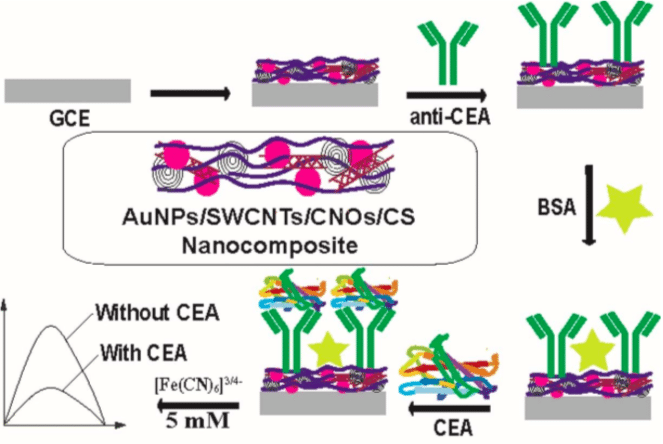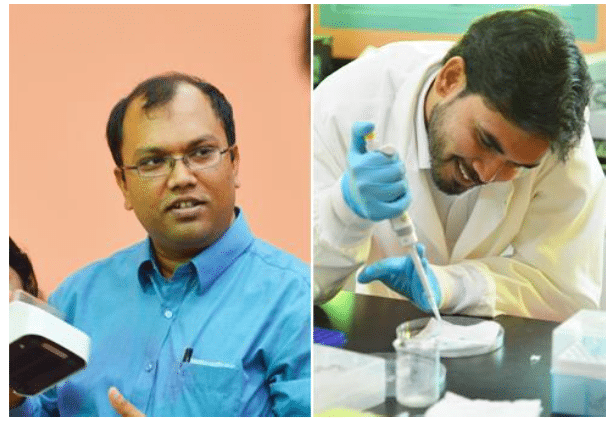
The carcinoembryonic antigen (CEA) is one of the most important clinical cancer biomarkers. It is reported that an increase in the concentration of CEA in adult plasma may be an early indication of a number of cancerous diseases, including colon tumors, breast tumors, ovarian carcinoma, colorectal cancer, and cystadenocarcinoma.
Since raised levels of plasma CEA may signify the presence of cancer and an indication of a possible disease, early detection of CEA, albeit at low concentrations, is an important step for controlling, effectively treating, monitoring, and screening disease recurrence.
Collaboration in nanotechnology and bioelectronics has uncovered new potential outcomes to scale down and fabricate highly sensitive label-free nanocomposite based immunosensor by exploring the highly conducting nature and surface area of the nanoparticles and nanomaterials. A nanocomposite of biopolymer, organic, and inorganic nanomaterials is one of the key research fields of today’s material science.
It combines the physicochemical attributes of each component and provides novel composite materials with their improved features. Nanoparticles (NPs) and nanomaterials (NMs) exhibit unique chemical, physical, and electronic properties that are different from their bulk counterparts, making them interesting for use with electrochemical sensors and biosensors.
Amongst metal NPs, gold nanoparticles (AuNPs) are the most extensively used due to their novel and unique biocompatible, large surface to volume ratio and electronic properties. The advantageous properties of carbon materials make them ideal electrodes in electroanalytical chemistry. With the continuous and rapid progress of nanoscience and nanotechnology in material sciences, carbon nanomaterials, particularly single-walled carbon nanotube (SWCNTs) and carbon nano-onions (CNOs), have emerged recently as an excellent biocompatible nanomaterial with great structural, mechanical, and electronic properties. Chitosan (CS) has been widely used as an immobilization matrix for biofabrication due to excellent membrane-forming ability, high permeability towards water, good adhesion, biocompatibility, and high mechanical strength.
Since the immobilization of biorecognition element onto the electrode surface is a crucial step for the construction of any electrochemical immunosensors, searching for an effective and simple immobilization method is of considerable interest. Therefore, for the first time, our group prepared a nanocomposite (AuNPs/CNOs/SWCNTs/CS) of AuNPs, CNOs, SWCNTs, and CS for the development of highly sensitive label-free electrochemical immunosensor for the detection of carcinoembryonic antigen, clinical cancer marker as shown in Figure 1.
Fabrication of the CEA-immunosensor AuNPs/CNOs/SWCNTs/CS-nanocomposite-modified glassy carbon electrode demonstrated a wide linear detection range of 100 fg mL-1 – 400 ng mL-1 with a low detection limit of 100 fg mL-1. In addition to high sensitivity, reproducibility, and large stability, the CEA-immunosensor provided an excellent selectivity and was resistant to interference in the presence of other antigens in serum, showing a potential to be used with real samples. This strategy provided an eco-friendly and economical method of label-free detection of the CEA without using any potentially dangerous reagent, radiation hazards and expensive devices.

Figure 1: Fabrication of the CEA-immunosensor (Republished with permission from Elsevier)
These findings are described in the article entitled AuNPs/CNOs/SWCNTs/Chitosan-Nanocomposite modified Electrochemical Sensor for the Label-free Detection of Carcinoembryonic Antigen, recently published in the journal Biosensors and Bioelectronics.
This work was conducted by Mohammad Rizwan, Syazwani Elma, Syazana Abdullah Lim and Minhaz Uddin Ahmed from the Universiti Brunei Darussalam.

-Minhaz Uddin Ahmed, Ph.D. (Project PI: left) and Mohammed Rizwan(Graduate Student: right)
References:
- Mohammad Rizwan, Syazwani Elma, Syazana Abdullah Lim, Minhaz Uddin Ahmed, AuNPs/CNOs/SWCNTs/Chitosan-Nanocomposite modified Electrochemical Sensor for the Label-free Detection of Carcinoembryonic Antigen, Biosensors and Bioelectronics, DOI: 10.1016/j.bios.2018.02.037 (2018).
- Syazana Abdullah Lim and Minhaz Uddin Ahmed, Electrochemical immunosensors and their recent nanomaterial-based signal amplification strategies: a review; RSC Advances 6, 24995-25014, (2016).









